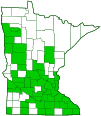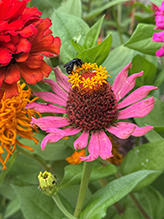Two-spotted longhorn bee
(Melissodes bimaculatus bimaculatus)
Conservation • Description • Habitat • Ecology • Distribution • Taxonomy
Conservation Status |
|||
| IUCN Red List | not listed |
||
| NatureServe | NNR - Unranked SNR - Unranked |
||
| Minnesota | not listed |
||
Description |
Two-spotted longhorn bee is a hairy, black, moderately large bee. It occurs in the United States from Maine west to eastern North Dakota and Colorado, and south to northern Florida and eastern Texas. Adults are active in late summer and fall when their preferred plants are in bloom. They feed on pollen from a wide variety of flowers in several plant families. The female is ½″ to ⅝″ (13 to 15 mm) in length. The hairs on the head are entirely black. The plate on the face above the upper lip (clypeus) is entirely black and unlobed. Each lateral margin of the clypeus touches the adjacent compound eye. The finger-like sensory appendages (palps) on the “under-jaws” (maxillae) have four segments. The antennae are black above, pale on the underside. They have 12 segments, a long scape at the base, a short pedicel, and a whip-like section (flagellum) with 10 segments (flagellomeres). The first flagellomere is much shorter than the second. The body is robust and nearly all black. The thorax and abdomen are densely covered with relatively long and more or less erect hairs. On the thorax the hairs are entirely black. On the abdomen the hairs are mostly black. There are sometimes a few white hairs on the extreme sides of segments 2 and 3. Segment 4 has a dense band of white hairs at the tip that is broadly interrupted in the middle, appearing as two bright white spots. This is the feature that gives the bee both its species epithet and its common name. The legs are black and are covered with black hairs. The fourth segment (tibia) on the hind legs has a pale, feather-like (plumose) tuft of pollen-collecting hairs (scopa). The last part of the leg (tarsus), corresponding to the foot, has five segments. The wings are uniformly tinged brownish and have brownish-black or black veins. There are three submarginal cells on the forewing. The second cell is shorter than first and third cells. The third cell is much longer than wide. The male is smaller, 7⁄16″ to ½″ (11 to 13 mm) in length. The antennae have 13 segments and are much longer. The clypeus is entirely yellow. There are white bands of hairs on segments 3, 4, and 5 that are very broadly interrupted in the middle. The hairs on segment 5 are much less dense then those on segment 4 of the female, and do not appear as bright white spots. There is a pair of robust spines at the base of the segment 7. The hairs on the tibia and the first tarsal segment (basitarsus) of the middle and hind legs are white. There is no scopa on the hind legs. |
Size |
Male: 7⁄16″ to ½″ (11 to 13 mm) Female: ½″ to ⅝″ (13 to 15 mm) |
Similar Species |
Habitat |
|
Ecology |
Season |
Late summer and fall |
Behavior |
|
Life Cycle |
|
Larva Food |
Pollen and nectar in the nest |
Adult Food |
Pollen of a wide variety of flowers in several plant families |
Threats |
Larvae are of Melissodes bimaculatus are parasitized by lunate longhorn-cuckoo (Triepeolus lunatus). his cuckoo bee is a cleptoparasite, meaning its larvae consume the pollen and nectar provisions gathered by the host bee for its own offspring, often after killing the host egg or larva. |
Distribution |
||
|
Sources Biodiversity occurrence data published by: Minnesota Biodiversity Atlas (accessed through the Minnesota Biodiversity Atlas Portal, bellatlas.umn.edu, 7/21/2025). |
|
| 7/31/2025 | ||
Occurrence |
||
|
||
Taxonomy |
|
Order |
Hymenoptera (Ants, Bees, Wasps, and Sawflies) |
Suborder |
Apocrita (Narrow-waisted Wasps, Ants, and Bees) |
Infraorder |
Aculeata (Ants, Bees, and Stinging Wasps) |
Superfamily |
Apoidea (Bees and Apoid Wasps) |
Epifamily |
|
Family |
Apidae (honey bees, bumble bees, and allies) |
Subfamily |
Apinae (honey, bumble, longhorn, orchid, and digger bees) |
Tribe |
Eucerini (longhorn bees) |
Genus |
|
Subgenus |
Melissodes |
Species |
Melissodes bimaculatus (two-spotted longhorn bee) |
There are two subspecies of Melissodes bimaculatus. Only Melissodes bimaculatus bimaculatus occurs north of Florida. |
|
Subordinate Taxa |
|
|
|
Synonyms |
|
Macrocera bimaculata Macrocera binotata Macrocera nigra Melissodes bimaculata Melissodes melanosoma Melissodes nigra |
|
Common Names |
|
two-spotted longhorn bee two-spotted long-horned bee |
|
Glossary
Clypeus
On insects, a hardened plate on the face above the upper lip (labrum).
Flagellomere
A segment of the whip-like third section of an insect antenna (flagellum).
Maxillae
Paired mouth structures of arthropods located immediately behind the mandible and used for tasting and manipulating food. “Under-jaws”.
Palp
Short for pedipalp. A segmented, finger-like process of an arthropod; one is attached to each maxilla and two are attached to the labium. They function as sense organs in spiders and insects, and as weapons in scorpions. Plural: palpi or palps.
Scopa
A brush-like tuft of hairs on the legs or underside of the abdomen of a bee used to collect pollen.
Tarsus
On insects, the last two to five subdivisions of the leg, attached to the tibia; the foot. On spiders, the last segment of the leg. Plural: tarsi.
Tibia
The fourth segment of an insect leg, after the femur and before the tarsus (foot). The fifth segment of a spider leg or palp. Plural: tibiae.
Visitor Photos |
Share your photo of this insect. |
||
This button not working for you? |
||
Mike Poeppe |
||
 |
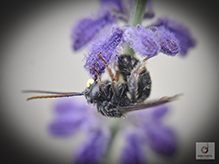 |
|
... after the rain today west of Houston, MN |
||
Justine Ruehle |
||
These guys are going crazy over our zinnias! Wile dead heading the zinnias one flew by my hand, at first glance I thought they might be a bald faced hornet and got worried. Definitely relieved they are two-spotted long horned bees! |
||
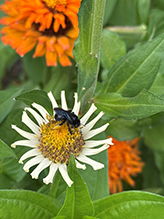 |
||
Babette Kis |
||
Melissodes bimaculatus two spotted longhorn bee On July 6-7, 2021, I found a number of these cute bees resting on Aster sp. on Barnes Prairie, Racine Co., Wisconsin early in the morning. |
||
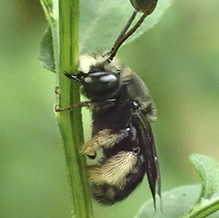 |
 |
|
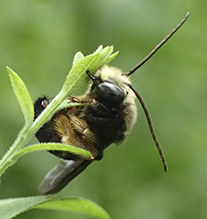 |
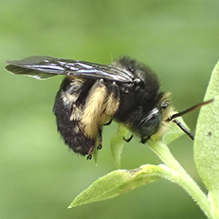 |
|
MinnesotaSeasons.com Photos |
|

Slideshows |
|

Visitor Videos |
Share your video of this insect. |
||
This button not working for you? |
||
|
Other Videos |
Black Long-horned Bee (Apidae: Melissodes bimaculata) |
About
Jun 24, 2010 Photographed at Grand Forks, North Dakota (24 June 2010). |
Black Long-horned Bee (Apidae: Melissodes bimaculata) on Leaf |
About
Jul 12, 2009 Photographed at Grand Forks, North Dakota (12 July 2009). |
Melissodes bimaculatus grooming |
About
Jan 25, 2021 |
Two-spotted Long-horned Bee (Melissodes bimaculata) closeup on Spotted beebalm (Monarda punctata) |
About
Jul 23, 2015 det. Sam Droege |
Melissodes bimaculatus |
About
Apr 1, 2017 |

Visitor Sightings |
Report a sighting of this insect. |
||
This button not working for you? |
||
Mike Poeppe |
Location: Houston, MN |
 |
| Mike Poeppe 8/7/2021 |
Location: west of Houston, MN ... after the rain today |
| Babette Kis 7/6 and 7/7/2021 |
Location: Barnes Prairie, Racine Co., Wisconsin On July 6-7, 2021, I found a number of these cute bees resting on Aster sp. on Barnes Prairie, Racine Co., Wisconsin early in the morning. |
MinnesotaSeasons.com Sightings |
|

|
Created: 9/13/2021 Last Updated: © MinnesotaSeasons.com. All rights reserved. |
